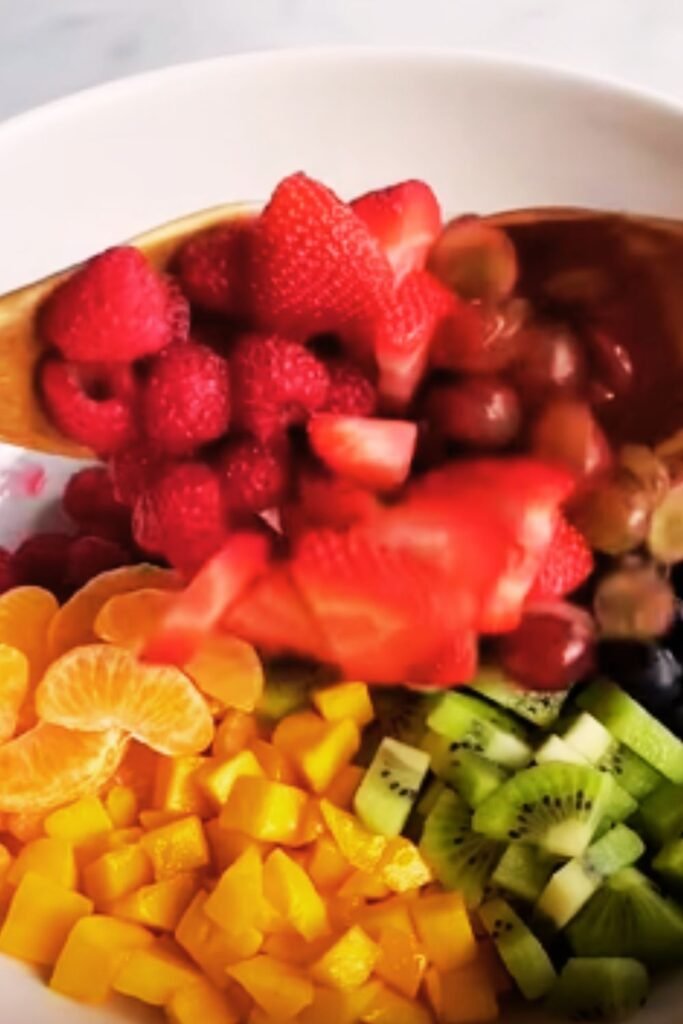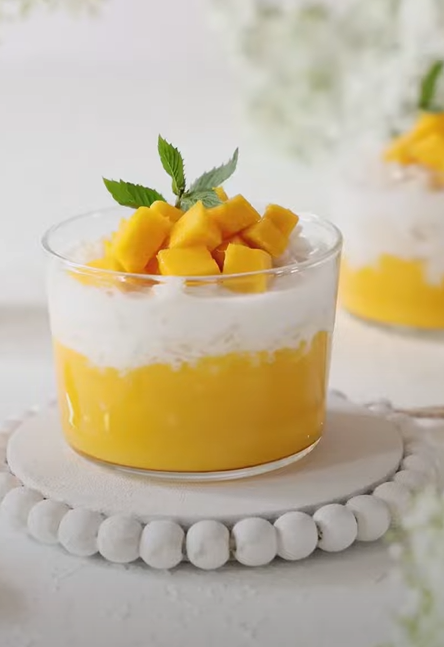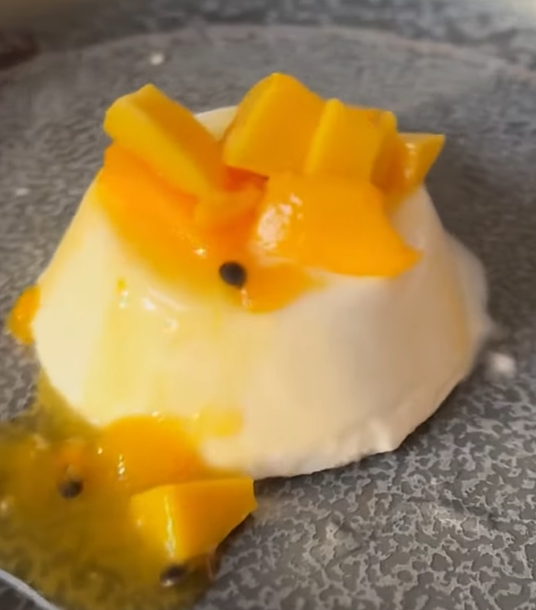There’s something magical about a perfectly crafted fruit salad that transforms ordinary fruits into an extraordinary celebration of flavors, colors, and textures. I’ve been perfecting my fruit salad recipes for over a decade, and I can tell you that the secret lies not just in selecting the right fruits, but in understanding how they complement each other and knowing the precise techniques that elevate this simple dish into something truly spectacular.
When I first started making fruit salads, I thought it was just about chopping fruits and mixing them together. How wrong I was! A truly exceptional fruit salad is an art form that requires careful consideration of seasonal availability, flavor profiles, textural contrasts, and presentation techniques. Today, I’m sharing my comprehensive guide to creating fruit salads that will have your family and friends asking for the recipe every single time.
Understanding the Foundation: Fruit Selection Mastery
The foundation of any outstanding fruit salad begins with understanding how different fruits interact with each other. I’ve learned through countless experiments that certain fruits are natural partners, while others can overwhelm or clash when combined incorrectly.
Sweet Fruits: These form the backbone of most fruit salads
- Pineapple: Provides tropical sweetness and natural enzymes
- Mango: Adds creamy texture and exotic flavor
- Grapes: Contribute juicy bursts and structural integrity
- Strawberries: Offer classic appeal and vibrant color
- Bananas: Create creaminess but require careful timing
Tart Fruits: These provide essential balance and prevent cloying sweetness
- Green apples: Add crunch and bright acidity
- Kiwi: Contributes unique flavor and visual appeal
- Oranges: Provide citrus brightness and natural juices
- Pomegranate seeds: Offer textural contrast and antioxidants
- Raspberries: Deliver intense flavor and delicate texture
Neutral Fruits: These act as flavor bridges and volume extenders
- Cantaloupe: Adds mild sweetness and substantial texture
- Honeydew: Provides refreshing coolness and bulk
- Pears: Contribute subtle flavor and satisfying bite
- Watermelon: Offers hydration and summer appeal
My Signature Rainbow Fruit Salad Recipe
After years of experimentation, I’ve developed what I consider the perfect balanced fruit salad recipe. This combination provides optimal flavor harmony, visual appeal, and nutritional diversity.
Ingredients (Serves 8-10)
| Fruit | Quantity | Preparation Method | Key Benefits |
|---|---|---|---|
| Fresh Pineapple | 2 cups, diced | Core removed, 1-inch chunks | Natural enzymes, tropical sweetness |
| Strawberries | 2 cups, hulled | Quartered lengthwise | Vitamin C, vibrant color |
| Green Grapes | 1½ cups | Halved lengthwise | Natural sugars, firm texture |
| Kiwi Fruit | 3 medium | Peeled, sliced rounds | Unique flavor, vitamin K |
| Mango | 1 large | Peeled, cubed | Beta-carotene, creamy texture |
| Orange | 2 medium | Supremed segments | Citrus brightness, natural juices |
| Blueberries | 1 cup | Whole, stems removed | Antioxidants, color contrast |
| Cantaloupe | 2 cups | Rind removed, cubed | Mild sweetness, substantial volume |
Flavor Enhancement Dressing
| Ingredient | Amount | Purpose | Alternative Options |
|---|---|---|---|
| Fresh Lime Juice | 3 tablespoons | Prevents browning, adds brightness | Lemon juice, orange juice |
| Honey | 2 tablespoons | Natural sweetness, binding | Maple syrup, agave nectar |
| Fresh Mint Leaves | 2 tablespoons, chopped | Aromatic freshness | Basil leaves, lemon balm |
| Vanilla Extract | ½ teaspoon | Depth and warmth | Almond extract, orange zest |
| Poppy Seeds | 1 teaspoon | Textural interest, nutty flavor | Chia seeds, sesame seeds |

Step-by-Step Preparation Method
Phase 1: Fruit Preparation Excellence
I always start with the fruits that require the most careful handling and work my way down to the more robust varieties.
Step 1: Citrus Supreming Technique Begin with your oranges using the supreming method I’ve perfected over the years. Using a sharp paring knife, cut away the peel and white pith completely. Then, carefully cut between the membranes to release perfect citrus segments. This technique eliminates bitter pith while preserving the natural juices that will enhance your entire salad.
Step 2: Pineapple Processing For pineapple, I use what I call the “spiral method.” After removing the crown and base, I cut away the skin in a spiral pattern, following the natural eyes. This preserves maximum fruit while ensuring no tough bits remain. Cut into uniform chunks approximately one inch in size for optimal eating experience.
Step 3: Delicate Fruit Handling Strawberries require gentle handling to maintain their shape and prevent mushiness. I hull them with a small paring knife, making a shallow circular cut around the stem. Quarter them lengthwise for the perfect bite-size pieces that won’t dominate other flavors.
Step 4: Stone Fruit Mastery When working with mangoes, I employ the “hedgehog technique.” Score the flesh in a crosshatch pattern while still attached to the pit, then invert the skin to pop out perfect cubes. This method maximizes fruit yield while creating uniform pieces.
Phase 2: Strategic Assembly Process
Step 5: Foundational Layer Creation In your largest mixing bowl, I recommend starting with the firmest fruits first. Begin with pineapple and cantaloupe as your base layer. These fruits hold their shape well and won’t be damaged by the weight of other ingredients.
Step 6: Building Flavor Layers Add your citrus segments next, allowing their natural juices to begin coating the foundation fruits. Follow with grapes and mango, creating layers that will distribute flavors evenly throughout the salad.
Step 7: Delicate Addition Sequence Save your most delicate fruits for last. Gently fold in strawberries, kiwi, and blueberries using a large spoon or silicone spatula. The key is minimal mixing to prevent crushing these tender fruits.
The Perfect Dressing Formula
Creating the ideal fruit salad dressing is where many people go wrong. I’ve discovered that the perfect dressing should enhance, not mask, the natural fruit flavors while providing just enough binding to create cohesion.
Dressing Preparation Method
Step 1: Citrus Base Creation In a small bowl, whisk together fresh lime juice and honey until completely smooth. The acidity from the citrus will prevent fruit browning while the honey provides natural sweetness that complements rather than competes with fruit sugars.
Step 2: Aromatic Enhancement Add vanilla extract and finely chopped mint leaves to your citrus-honey base. The vanilla adds unexpected depth, while mint provides refreshing coolness that makes the salad feel lighter and more sophisticated.
Step 3: Textural Element Integration Fold in poppy seeds last, as they provide subtle crunch and visual interest. These tiny seeds also contain natural oils that help bind the dressing ingredients together.
Application Technique
Pour the dressing over your assembled fruit and use a gentle folding motion to distribute it evenly. I’ve found that using two large spoons in a lifting and folding motion works better than stirring, which can break delicate fruits.
Advanced Seasonal Variations
Throughout my years of fruit salad making, I’ve developed specialized variations that celebrate each season’s unique offerings.
Spring Awakening Variation
| Seasonal Fruit | Quantity | Special Preparation | Flavor Profile |
|---|---|---|---|
| Fresh Strawberries | 3 cups | Macerated with sugar | Intense berry sweetness |
| Rhubarb | 1 cup | Lightly poached | Tart complexity |
| Early Peaches | 2 medium | Blanched, peeled | Delicate stone fruit |
| Fresh Mint | ¼ cup | Torn, not chopped | Aromatic freshness |
Summer Abundance Variation
| Seasonal Fruit | Quantity | Special Preparation | Flavor Profile |
|---|---|---|---|
| Watermelon | 3 cups | Seeded, large chunks | Cooling hydration |
| Fresh Berries Mix | 2 cups | Gentle rinse, dried | Concentrated berry flavors |
| Stone Fruit Medley | 2 cups | Pitted, wedged | Rich, sweet complexity |
| Basil Leaves | 2 tablespoons | Chiffonade cut | Herbaceous sophistication |
Autumn Harvest Variation
| Seasonal Fruit | Quantity | Special Preparation | Flavor Profile |
|---|---|---|---|
| Crisp Apples | 2 cups | Julienned | Crunchy sweetness |
| Fresh Pears | 2 cups | Cored, diced | Subtle autumn flavors |
| Pomegranate Seeds | ½ cup | Carefully extracted | Tart jewel-like bursts |
| Toasted Walnuts | ⅓ cup | Roughly chopped | Nutty richness |
Professional Presentation Techniques
The visual presentation of your fruit salad can transform it from a simple side dish into an impressive centerpiece. I’ve learned several professional techniques that create restaurant-quality presentations at home.
Layered Glass Bowl Method
Using a clear glass bowl, create distinct color layers by carefully spooning each fruit variety in separate sections. Start with darker fruits at the bottom and work toward lighter colors at the top. This creates a stunning rainbow effect that showcases each fruit’s natural beauty.
Individual Serving Cups
For special occasions, I prepare individual portions in clear glasses or small bowls. This allows for more precise portioning and creates an elegant, restaurant-style presentation that guests always appreciate.
Garnish Enhancement Strategies
Fresh mint sprigs, edible flowers, or a light dusting of coconut flakes can elevate your presentation dramatically. I often reserve the most beautiful fruit pieces for surface garnishing, creating visual focal points that draw the eye.
Storage and Food Safety Mastery
Proper storage techniques are crucial for maintaining both food safety and optimal flavor in fruit salads. I’ve developed a comprehensive approach that ensures maximum freshness and safety.
Optimal Storage Conditions
| Storage Factor | Recommendation | Duration | Quality Impact |
|---|---|---|---|
| Temperature | 35-38°F (2-3°C) | Up to 3 days | Maintains crispness |
| Container Type | Airtight, non-reactive | Glass or BPA-free plastic | Prevents oxidation |
| Preparation Timing | Same day serving | Within 4 hours | Peak flavor and texture |
| Dressing Application | Just before serving | Last 30 minutes | Prevents fruit breakdown |
Food Safety Protocols
Always wash all fruits thoroughly before cutting, even those you’ll be peeling. I use a dedicated cutting board for fruits only, and I ensure all utensils are clean and sanitized. Cross-contamination prevention is essential, especially when serving to large groups or individuals with compromised immune systems.
Nutritional Benefits Analysis
Understanding the nutritional powerhouse you’re creating helps appreciate why fruit salads are such valuable additions to any meal plan.
Comprehensive Nutritional Breakdown
| Nutrient Category | Primary Sources | Health Benefits | Daily Value Contribution |
|---|---|---|---|
| Vitamin C | Strawberries, Kiwi, Oranges | Immune support, collagen synthesis | 150-200% DV per serving |
| Fiber | All fruits, especially apples | Digestive health, satiety | 15-20% DV per serving |
| Potassium | Cantaloupe, Bananas, Oranges | Heart health, blood pressure regulation | 12-15% DV per serving |
| Antioxidants | Blueberries, Pomegranate, Grapes | Cellular protection, anti-aging | Varied, significant amounts |
| Natural Sugars | All fruits | Quick energy, brain function | Balanced with fiber for stable energy |
Serving Suggestions and Pairings
The versatility of fruit salad makes it perfect for numerous serving occasions and meal pairings. I’ve discovered combinations that enhance both the fruit salad and its accompanying dishes.
Breakfast Enhancement Options
Serve over Greek yogurt for added protein and probiotics. The creamy tanginess of yogurt provides an excellent contrast to sweet fruit flavors while creating a more substantial meal. I often add a sprinkle of granola or chopped nuts for additional texture and nutrition.
Light Lunch Combinations
Pair with cottage cheese and whole grain crackers for a balanced, refreshing meal. The protein from cottage cheese complements the natural sugars in fruit, creating sustained energy without heaviness.
Dinner Party Elegance
As a palate cleanser between courses, small portions of fruit salad can refresh the palate and prepare guests for the next course. I often serve these in small glasses with a mint garnish for sophisticated presentation.
Dessert Alternative Excellence
Instead of heavy desserts, a well-crafted fruit salad provides natural sweetness and satisfaction. I sometimes add a small amount of dark chocolate shavings or toasted coconut for special occasions.
Troubleshooting Common Issues
Through years of fruit salad creation, I’ve encountered and solved numerous common problems that can affect both flavor and presentation.
Preventing Fruit Browning
Beyond using citrus juice, I’ve found that proper storage and timing are crucial. Never cut bananas or apples more than an hour before serving, and always add citrus dressing immediately after cutting susceptible fruits.
Managing Texture Issues
Some fruits release more juice than others, potentially making your salad watery. I counter this by using firmer fruits as the base and adding juicier fruits just before serving. Additionally, gentle handling prevents fruit from breaking down prematurely.
Balancing Sweetness Levels
When fruits vary in ripeness, sweetness levels can be inconsistent. I taste-test my salad before serving and adjust with small amounts of honey or lime juice to achieve perfect balance.
Addressing Presentation Problems
If your fruit salad looks flat or monochromatic, strategic garnishing can solve the issue. Reserved colorful fruits, fresh herbs, or even edible flowers can transform the visual appeal dramatically.
Frequently Asked Questions
Q: How far in advance can I prepare fruit salad? I recommend preparing fruit salad no more than 4 hours before serving for optimal texture and flavor. The citrus dressing helps preserve freshness, but delicate fruits will begin to break down after this timeframe.
Q: Can I freeze leftover fruit salad? While technically possible, I don’t recommend freezing fruit salad as it significantly changes the texture of most fruits. The high water content in fruits creates ice crystals that break down cell walls, resulting in mushy fruit when thawed.
Q: What’s the best way to transport fruit salad for picnics or potlucks? Use a well-sealed, insulated container and keep it on ice during transport. I prefer containers with tight-fitting lids and often pack the dressing separately to add just before serving, ensuring maximum freshness.
Q: How do I know when fruits are perfectly ripe for fruit salad? Each fruit has specific ripeness indicators. Pineapples should smell sweet at the base, mangoes should yield slightly to gentle pressure, and berries should be plump with vibrant color. I’ve learned that slightly underripe fruits often work better in salads as they hold their shape better.
Q: Can I substitute dried fruits for fresh fruits in recipes? While possible, dried fruits behave very differently in salads. They absorb moisture from other fruits and dressing, changing the overall texture. If using dried fruits, I recommend soaking them briefly in warm water first and using them sparingly as accent ingredients rather than main components.
Q: What’s the secret to getting restaurant-quality presentation at home? The key lies in uniform cutting, strategic layering, and thoughtful garnishing. I always cut fruits into similar-sized pieces, arrange them thoughtfully in the serving bowl, and finish with carefully placed garnishes that complement both color and flavor.
Q: How do I prevent my fruit salad from becoming too sweet or too tart? Balance is achieved through careful fruit selection and tasting throughout preparation. I always include both sweet and tart elements, and I adjust the dressing accordingly. Start with less sweetener and add gradually until you achieve the perfect balance for your taste preferences.
Q: Is it safe to serve fruit salad to people with food allergies? Always check with guests about specific fruit allergies, which are less common than other food allergies but can be serious. Some people have oral allergy syndrome, which can cause reactions to certain fresh fruits. When in doubt, provide a detailed ingredient list and prepare the salad in a clean environment free from cross-contamination.


